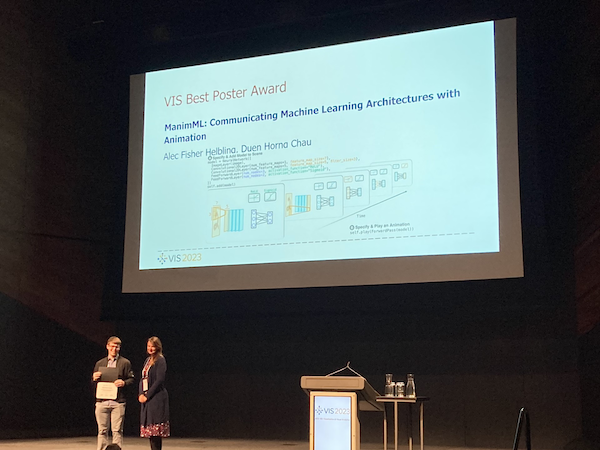
Machine Learning Animation Tool Takes Best Poster Prize at Visualization Conference
Georgia Tech researchers have created a machine learning (ML) visualization tool that must be seen to believe.
Ph.D. student Alec Helbling is the creator of ManimML, a tool that renders common ML concepts into animation. This development will enable new ML technologies by allowing designers to see and share their work in action.
Helbling presented ManimML at IEEE VIS, the world’s highest-rated conference for visualization research and second-highest rated for computer graphics. It received so much praise at the conference that it won the venue’s prize for best poster.
“I was quite surprised and honored to have received this award,” said Helbling, who is advised by School of Computational Science and Engineering Associate Professor Polo Chau.
“I didn't start ManimML with the intention of it becoming a research project, but because I felt like a tool for communicating ML architectures through animation needed to exist.”
ManimML uses animation to show ML developers how their algorithms work. Not only does the tool allow designers to watch their projects come to life, but they can also explain existing and new ML techniques to broad audiences, including non-experts.
ManimML is an extension of the Manim Community library, a Python tool for animating mathematical concepts. ManimML connects to the library to offer a new capability that animates ML algorithms and architectures.
Helbling chose familiar platforms like Python and Manim to make the tool accessible to large swaths of users varying in skill and experience. Enthusiasts and experts alike can find practical use in ManimML considering today’s widespread interest and application of ML.
“We know that animation is an effective means of instruction and learning,” Helbling said. “ManimML offers that ability for ML practitioners to easily communicate how their systems work, improving public trust and awareness of machine learning.”
ManimML overcomes what has been an elusive approach to visualizing ML algorithms. Current techniques require developers to create custom animations for every specific algorithm, often needing specialized software and experience.
ManimML streamlines this by producing animations of common ML architectures coded in Python, like neural networks.
A user only needs to specify a sequence of neural network layers and their respective hyperparameters. ManimML then constructs an animation of the entire network.
“To use ManimML, you simply need to specify an ML architecture in code, using a syntax familiar to most ML professionals,” Helbling said. “Then it will automatically generate an animation that communicates how the system works.”

ManimML ranked as the best poster from a field of 49 total presentations. IEEE VIS 2023 occurred Oct. 22-27 in Melbourne, Australia. This event marks the first time IEEE held the conference in the Southern Hemisphere.
ManimML has more than 23,000 downloads and a demonstration on social media has hundreds of thousands of views.
ManimML is open source and available at: https://github.com/helblazer811/ManimML
As computing revolutionizes research in science and engineering disciplines and drives industry innovation, Georgia Tech leads the way, ranking as a top-tier destination for undergraduate computer science (CS) education. Read more about the college's commitment:… https://t.co/9e5udNwuuD pic.twitter.com/MZ6KU9gpF3
— Georgia Tech Computing (@gtcomputing) September 24, 2024


